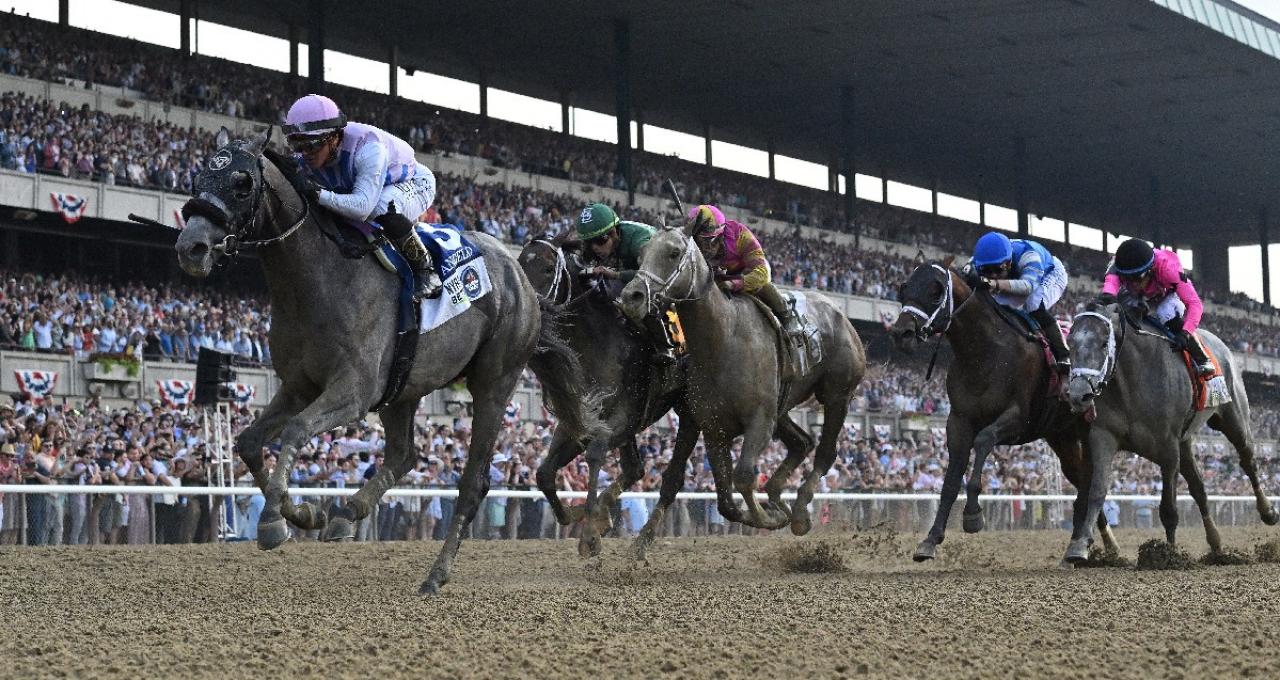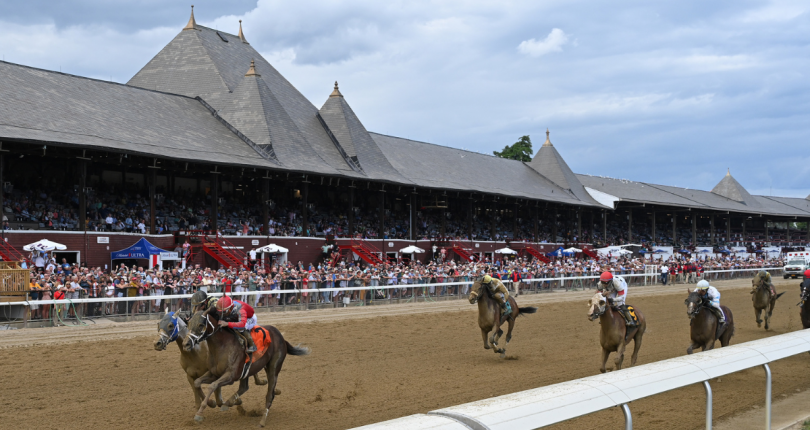
The Belmont Stakes: A race of both tradition and change
by Brian Bouyea
Paid banners below are not related to Belmont Stakes Ticket Sales.
Throughout its remarkable history, the Belmont Stakes has been defined in large part by the celebrated traditions of its distance, location, and stature. At 1 1/2-miles on the dirt at the iconic Belmont Park, the race matured into an American institution as the third jewel in the famed Triple Crown series. A deep dive into the Belmont’s archives, however, reveals an event with a legacy that has experienced significant changes to many of its characteristics since the inaugural edition in 1867.
Long referred to as the “Test of the Champion,” the Belmont has been a signature contest in thoroughbred racing since its inception, a challenge requiring the talent, stamina, and heart possessed by all great racehorses. But while the traits of its winners have remained consistent, the race itself has undergone substantial variations. Distance, location, and race conditions have fluctuated…and that’s only the beginning. Customarily held in early June, the Belmont once took place in November. There was also an edition that was held at the same track on the same card as the Preakness Stakes. Truth really can be stranger than fiction.
America was in a traumatic struggle to piece itself back together in the aftermath of the physical carnage and emotional strife of the Civil War when Hall of Fame filly Ruthless won the first Belmont in 1867 at the grand old venue of Jerome Park in New York’s Westchester County.
The contest was named for August Belmont, I, a wealthy financier and sportsman, who helped fund Jerome Park’s construction and served as its first president. The Preakness was still six years away from its first edition when Ruthless ruled the Belmont, and it would be another two years after that before the inaugural Kentucky Derby took place.
Jerome Park played host to the first 23 runnings of the Belmont from 1867 through 1889. When that track closed, Morris Park — built near Jerome Park on land that was annexed into the Bronx — served as the race’s home from 1890 through 1904.
By the time Belmont Park opened in 1905, the Belmont Stakes had already been contested 38 times at two sites and five distances: 1 5/8-miles from 1867 through 1873; 1 1/2- miles from 1874 through 1889; 1 1/4-miles from 1890 through 1892 and in 1895 and 1904; 1 1/8-miles in 1893 and 1894; and 1 3/8-miles from 1896 through 1903.
One of the more obscure editions of the Belmont Stakes was the 1890 running won by Burlington, the first year the race was held at Morris Park. A crowd of 15,000 was on hand and the spectators had the unique experience of also witnessing that year’s Preakness, an undercard race won by 5-year-old gelding Montague under handicap conditions and without an age restriction. That was the lone year the Preakness was held at Morris Park, as the race was discontinued from 1891 through 1893. It resurfaced at another New York track, Gravesend, from 1894 through 1908, then found its way to its traditional home of Pimlico Race Course in Baltimore in 1909.
Back to the Belmont Stakes, another oddity of the 1890s was the 1895 edition being postponed and almost scrapped because of new laws that banned bookmaking in New York; it was eventually rescheduled for November 2. Won by Belmar [also that year’s Preakness winner], the 1895 Belmont race chart noted that the “New York Jockey Club closed out its affairs. Race run under the jurisdiction of the Westchester Racing Association.”
One of the most notable renewals of the Belmont was the first one held at Belmont Park in 1905. A chestnut filly named Tanya stole the show and earned her place in Belmont lore by becoming the first filly since Ruthless to win the race. After Tanya, 102 years passed before another filly, champion Rags to Riches, achieved the glory of a Belmont victory.
Since its 1905 opening, Belmont Park has played host to its namesake race annually, with the only exceptions being 1963 through 1967, when a renovation project necessitated a move to Aqueduct. The race was not contested in 1911 and 1912, when the sport was shut down in New York because of anti-gambling legislation. After that two-year hiatus, the 1913 Belmont was run as a handicap; Prince Eugene won carrying only 109 pounds compared to the runner-up lugging 126 pounds. Prior to 1900, the Belmont had a variety of weight conditions. The modern parameters of the race are 126 pounds for colts and geldings and 121 pounds for fillies.
Thirteen horses — Sir Barton (1919), Gallant Fox (1930), Omaha (1935), War Admiral (1937), Whirlaway (1941), Count Fleet (1943), Assault (1946), Citation (1948), Secretariat (1973), Seattle Slew (1977), Affirmed (1978), American Pharoah (2015), and Justify (2018) — have stamped themselves as immortals by winning the Triple Crown, but the history of the calendar placement for the Kentucky Derby, Preakness, and Belmont has been jumbled on numerous occasions.
Since 1931, the order of Triple Crown races has been the Kentucky Derby first, followed by the Preakness, and then the Belmont. Before the current established coordination of the series, the Preakness was run before the Derby 11 times. Twice, in 1917 and 1922, the Preakness and the Derby were held on the same day. On 11 occasions, the Belmont was run before the Preakness. The date of each event now follows the positioning of the Derby, which is annually slotted for the first Saturday in May.
The Preakness takes place two weeks after the Derby, and the Belmont concludes the series three weeks after the Preakness. The only exception to this since 1931 was in 2020, when the COVID-19 pandemic necessitated the Belmont leading off the series on June 20, followed by the Derby on September 5, and finally the Preakness on October 3. The 2020 Belmont was also shortened to 1 1/8-miles, marking the only time since 1926 the race has not been contested at 1 1/2-miles.
The early years of the Belmont Stakes featured some of the top thoroughbreds in the sport’s history. Prior to Sir Barton becoming America’s first Triple Crown winner in 1919, the Belmont had already been won by eight horses that were eventually elected to the Hall of Fame: Ruthless (1867), Harry Bassett (1871), Duke of Magenta (1878), Hanover (1887), Henry of Navarre (1894), Commando (1901), Peter Pan (1907), and Colin (1908).
The term “Triple Crown” was not popularized until the 1930s, when Gallant Fox and his son, Omaha, came along. As accomplished as he was, inaugural Triple Crown winner Sir Barton’s legacy was quickly overshadowed when the mighty Man o’ War arrived on the scene. Owned by Samuel D. Riddle, Man o’ War was not entered in the Kentucky Derby in 1920, but he won the Preakness with ease and dominated the Belmont by 20 lengths.
The New York Times ran a headline pronouncing Man o’ War’s Belmont victory as a “Speed Miracle.”
The Times reported: “Samuel D. Riddle’s marvelous race horse, Man o’ War, gave at Belmont Park yesterday what was beyond a doubt the greatest exhibition of speed ever witnessed on any race track when he shattered the world’s record for a mile and three furlongs in winning the $10,000 Belmont Stakes, while a crowd of 25,000 sat stunned by the almost unbelievably brilliant performance. The champion did not just clip the mark, but literally shattered it, for he ran the distance in 2:14 1-5, which is two and three-fifths seconds faster than any horse had ever run it before…
“The race left no doubt in the minds of all turfmen present that they had seen the greatest horse of this or any other age. Man o’ War would seem to typify the final goal of breeders, the perfect race horse, gifted with all the essentials of greatness.”
A footnote to Man o’ War’s Belmont victory was that it was the last of 51 editions run in the English tradition of the clockwise direction. In 1921, the route was flipped to counterclockwise, which has remained the format ever since.
Count Fleet’s 25-length margin of victory in 1943 stood as the Belmont record until Secretariat’s 31-length romp in 1973. Secretariat also ended a 25-year drought between Triple Crowns and his time of 2:24 set and remains both the Belmont and American record for the distance on dirt 51 years later. CBS announcer Chic Anderson famously described Secretariat as a “tremendous machine” during his jaw-dropping Belmont run. More than 50 years later, the legacy of Secretariat and what he accomplished on June 9, 1973, remains the standard by which all others are measured in racing and, specifically, the Belmont.
The 1970s also produced Seattle Slew, the first horse to successfully navigate the gauntlet of the Triple Crown undefeated, as well as Affirmed, whose thrilling victory by a nose over Alydar in the 1978 Belmont capped what is widely considered the greatest rivalry in the history of the Triple Crown series.
The Belmont has also been known for monumental upsets and has thwarted many Triple Crown hopefuls. Twenty-three horses that won both the Derby and Preakness have failed in their attempt to win the Belmont, including Hall of Famers such as Northern Dancer, Spectacular Bid, Silver Charm, Sunday Silence, and Alysheba.
A record crowd of 120,139 attended the 2004 Belmont when Smarty Jones was denied the Triple Crown by Marylou Whitney’s Birdstone. It was the third straight year a Triple Crown hopeful was defeated in the Belmont. The gracious Whitney, understanding the impact of a potential Triple Crown on the sport, apologized to the owners of Smarty Jones for her horse winning the race. When California Chrome faded in the stretch of the 2014 Belmont with a Triple Crown on the line, many wondered if the sport would ever see another horse accomplish the feat. Then came American Pharoah in 2015 and Justify three years later.
More history will be made in 2024 with the 156th running of the Belmont Stakes taking place at Saratoga Race Course. The move to the Spa City and America’s oldest racetrack coincides with Belmont Park undergoing a transformative modernization project, the first significant upgrades to the venerable facility since the 1960s. The Belmont at Saratoga will be run at 1 1/4-miles.
Although it has experienced many changes, the historical significance of the Belmont Stakes is indisputable. A total of 40 Belmont winners have been immortalized in the Hall of Fame, more than both the Kentucky Derby [36] and Preakness Stakes [34].
Indeed, the Belmont Stakes is the “Test of the Champion.”
Brien Bouyea is the Hall of Fame and Communications Director at the National Museum of Racing and Hall of Fame in Saratoga Springs, New York. He is also the author of Bare Knuckles and Saratoga Racing: The Remarkable Life of John Morrissey and co-author of The Travers: 150 Years of Saratoga’s Greatest Race.








 Gambling Problems? The New York Racing Association encourages responsible wagering. If gambling is a problem for you or someone you care about, help is available 24 hours a day. Scan here to talk with someone now about your gambling. Or call toll-free 1-877-8-HOPE-NY.
Gambling Problems? The New York Racing Association encourages responsible wagering. If gambling is a problem for you or someone you care about, help is available 24 hours a day. Scan here to talk with someone now about your gambling. Or call toll-free 1-877-8-HOPE-NY.